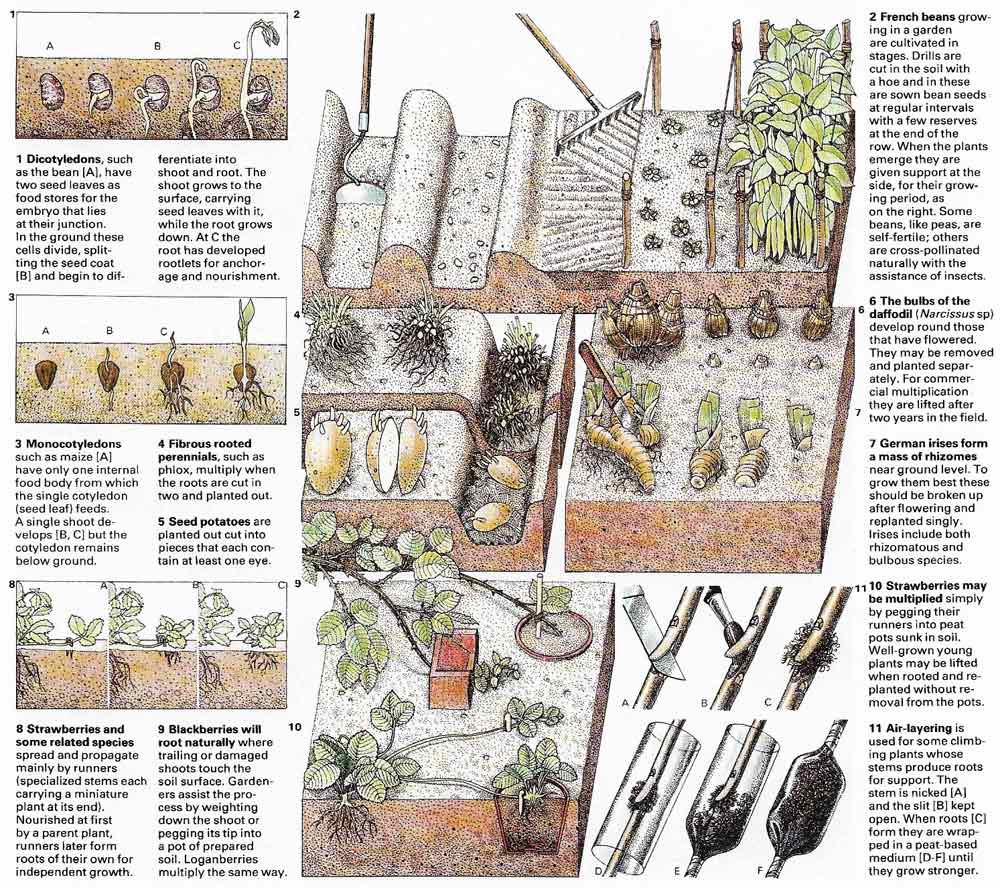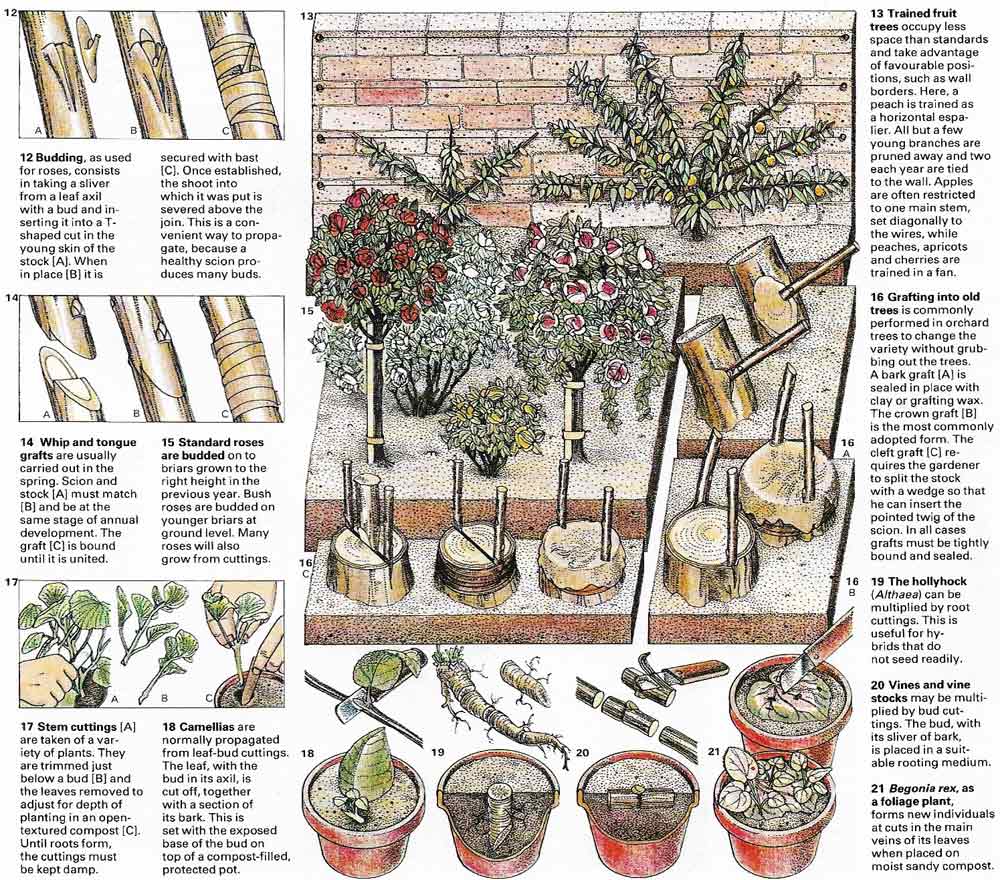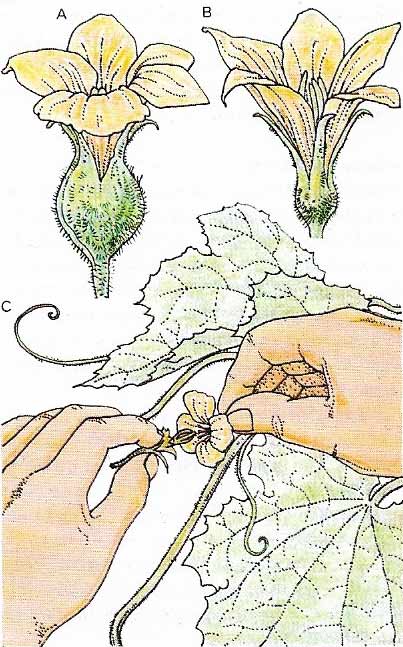plant propagation



Pollination is vital to the production of normal fruits. The process is usually left to insects, but they are not always to be relied upon in glasshouses. The family Cucurbitaceae – which includes marrows and melons – offers difficulties because male and female elements are carried by separate flowers whose number may not balance. To ensure that the greatest number of female flowers are fertilized, gardeners generally resort to hand pollination. Pollen from the male melon flower (B) is transferred by hand to the stigma of the female (A). Hand pollination is also used with marrows, but not with cucumbers, which are best eaten without seeds.
Flowering plants reproduce themselves by means of seeds and many, in addition, by vegetative means that bypass the normal sexual process. Given the appropriate stimulus, plant tissues, apparently specialized by virtue of their position and function, can change their character. Stem tissue or even leaves, for instance, may develop roots and this adaptability has long been exploited by man. Some wild species spread as much by vegetative means as by seed. Examples include such troublesome weeds as couch grass (Agropyron repens) and ground elder (Aegopodium podagraria), which form new plants at the joints of underground rhizomes. Such monocotyledons as tiger lily (Lilium tigrinum) form bulbils in the mils of their leaves, or – like some onions (Allium sp) – in place of a normal flower head.
Growing from clones
A group of plants can be grown vegetatively from a single specimen. Such a group is genetically homogeneous and is called a clone. Every named potato, apple or rose is a continuation from the original plant, which began as a hybrid seed. A hybrid may not be able to produce fertile seed itself; but even if it can, a clone (developed by grafting or budding) is less variable and more predictable than its parents. Grafted shrubs and trees can be brought to maturity more quickly than seedlings.
A potato tuber consists of a large mass of food storage cells, with cells adapted to growth just below the skin at the "eyes". Any small piece containing an "eye" is capable of developing into a new plant (5). In fact botanists have produced new plants from microscopic cell material taken from the extreme point of a growing shoot. These cells will be free from any virus that may be present in the rest of the plant and can be grown on to develop a virus-free clone. Many crops have been improved by this method, notably the King Edward variety of potato.
Stem cuttings are a convenient way of multiplying many ornamental species, timber trees (such as willows and poplars) and shrubs (17). The process of rooting is accelerated by the use of synthetic plant hormones, which encourage a change in the function of the cells. Leaf cuttings are used to multiply species of gloxinia and of those begonias (21) grown for their decorative foliage. If the gardener removes the midrib of the leaf and fixes the leaf to a suitably moist base, new plants develop at the inner ends of the cross-ribs.
The family Rosaceae, to which much of our fruit belongs, lends itself well to vegetative multiplication. Strawberries [8] throw out runners from which new plants develop. In the genus Rubus, raspberries (R. idaeus) spread by way of underground rhizomes. Blackberries (R. fruticosus and subspecies) and their hybrid the loganberry, which are climbing plants, will root wherever a trailing stem touches the ground; the deliberate encouragement of this form of growth is known as layering (9).
Growing from grafts
Tree fruits of the rose order (apples, pears, plums, peaches, apricots and cherries) develop quite freely from seed but the seed-lings vary in quality. Practically all those in cultivation are clones – often of a chance seedling, such as Cox's Orange Pippin. A nurseryman grafts a cutting on to a young tree of the same or closely allied species. The type of stock he uses will often determine the rate of growth and the size of the mature tree or bush. In making a graft it is essential to align the cambium layer (a thin layer of stem tissue-forming cells) under the bark of both scion (the new plant material) and stock (the host plant), since it is the active cambial tissue that fuses and that is subsequently responsible for the "in step" production of water-and nutrient-conducting tissues (16). The scion is normally a short length of twig of the desired type, trimmed to fit exactly into the prepared stock. The practice of grafting trees and shrubs has a long history, dating back to classical times, when it was used particularly for propagating vines.
Propagating roses
Budding, as practiced with roses, is a variant of the same technique (12). A bud of the desired clone, with a small spur of stem sheath, is inserted on to the exposed soft stem of a young briar (wild rose) stock. The species most commonly used is the very variable dog rose (Rosa canina). A standard rose is budded on young lateral shoots at the desired height, close to the main stem of the briar. For a bush rose the budding is done at ground level on two-year-old briar seedlings. Once the bud comes into growth, the gardener trims away the rest of the briar to concentrate the plant's whole activity into the developing scion. He may also graft stem cuttings to the briar; this is in fact normal for ramblers and some other climbing types.
Much research has been carried out in recent years into the selection and breeding of stocks for grafting and budding and the range is now large. Horticulturists have paid particular attention to the production of dwarfing stocks for modern orchards. The dwarf trees permit closer planting with less labor when the time comes for pruning and picking the fruit.
Root cuttings may be used for the propagation of some herbaceous plants (19). Included among them are species of Acanthus, Anchusa, Romneya, and, in the kitchen garden, horseradish (Armoracia rusticana) and seakale (Crambe maritima).
